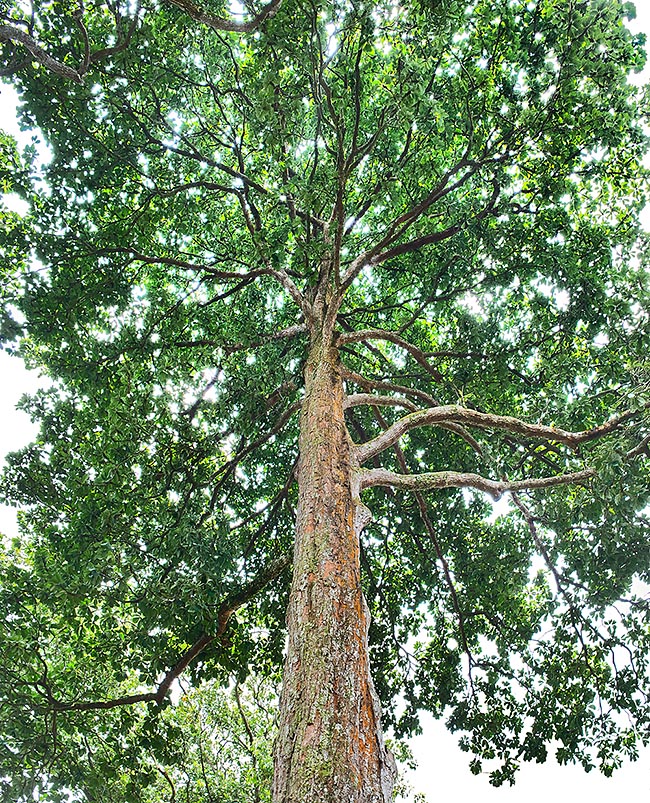Family : Sapotaceae

Text © Pietro Puccio

English translation by Mario Beltramini

Common in South-East Asian forests, Palaquium obovatum reaches 40 m with an 80 cm trunk © Giuseppe Mazza
The name of the genus is one used in the Philippines; the name of the species is the Latin adjective “obovatus, a, um” = obovate, with reference to the shape of the leaf.
Common names: white gutta (English); hangkang, mayang katapong, njatuh (Indonesian); getah taban putih, nyatoh (Malaysian); nyatoh puteh (Singaporean); balam putih (Sumatran); xay đào, chây, cốt, giao mộc trứng ngược (Vietnamese).
The Palaquium obovatum (Griff.) Engl. (1890) is an evergreen tree with cylindrical crown, 30-40 m tall, with trunk of up to 80 cm of diameter, which, in the oldest specimens presents at the base tabular roots (flattened roots similar to buttresses contributing to the support of the tree); the bark is greyish brown, vertically fissured and the young branches are covered by reddish tomentum. The leaves, on a 1,5-3 cm long petiole, grouped at the apex of the branches, are alternate, simple, entire, obovate-lanceolate with obtuse or brusquely pointed apex, cuneate base and prominent central nervation, 10-30 cm long and 4-12 cm broad, coriaceous, of glossy intense green colour above, covered by a glaucous tomentum below. Inflorescences in axillar clusters of 1-10 flowers, on a 0,7-1,5 cm long pedicel covered by reddish tomentum, with campanulate calyx with 6 sepals arranged in two verticils, the three outer ones pointed, about 4 mm long, and 3 inner ones obtuse, 2 mm long , corolla of 2-3 cm of diameter, containing 1-2 ellipsoid seeds of brown colour, about 2 cm long.
Imposing species practically unknown out from its origin zones, cultivable in full sun in the tropical and subtropical humid climate zones; it is not particular about the soil, provided deep, draining and maintained almost constantly humid.
In the past, the latex was used for getting the gutta-percha, but of poorer quality than that obtained from other species belonging to the genus, in particular from Palaquium gutta (Hook.) Baill. (1884).
The wood, of reddish colour, has good characteristics of hardness and of resistance to the xylophagous insects, is used for furniture, fixtures, floors and internal joinery; being long-lasting also in water, it is used also for submerged structures and boats.
Synonyms: Isonandra obovata Griff. (1854); Bassia hypoleuca Miq. (1861); Bassia krantzii Hance (1876); Dichopsis krantziana Pierre (1881); Dichopsis helferi C.B.Clarke (1882); Dichopsis obovata (Griff.) C.B.Clarke (1882); Palaquium celebicum Burck (1885); Palaquium cinereum Burck (1885); Palaquium cupreum Burck (1885); Palaquium minahassae Burck (1885); Palaquium montgommerianum Burck (1885); Palaquium oxleyanum Burck (1885); Palaquium helferi (C.B.Clarke) Engl. (1890); Palaquium obovatum King & Gamble (1906); Palaquium theoideum Elmer (1910); Isonandra krantziana (Pierre) Pierre (1920); Palaquium krantzianum Pierre ex Lecomte (1930); Palaquium punctatum Fletcher (1937).
→ To appreciate the biodiversity within SAPOTACEAE family please click here.
